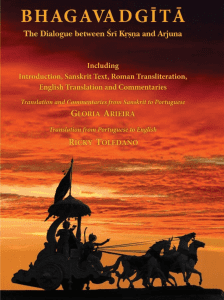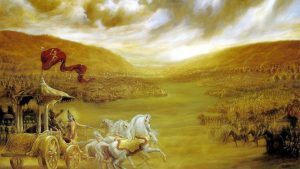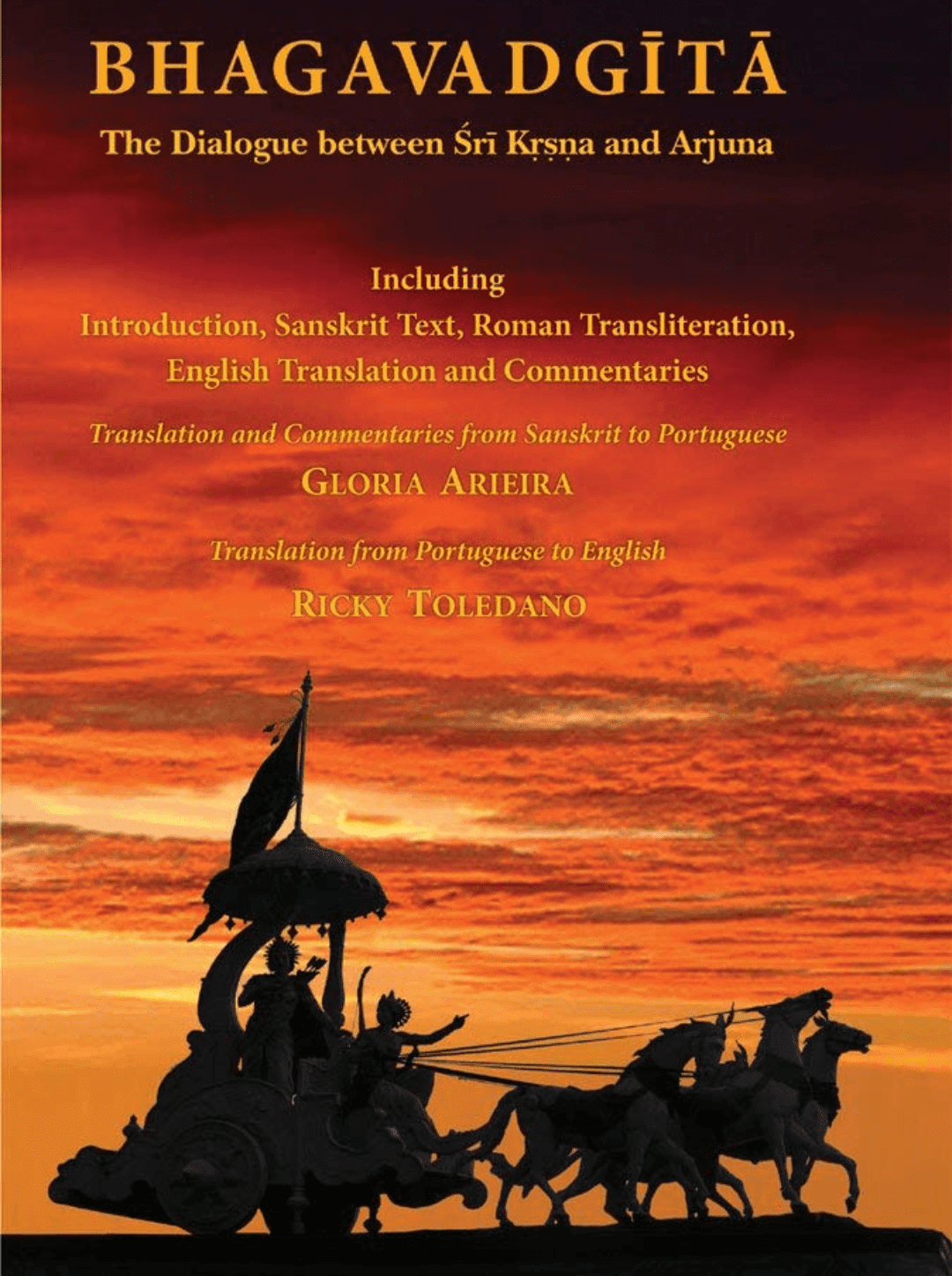Reading Time: 8 minutes
Soma reviews Bhagavad Gita, which was translated into Portouguese, from Sanskrit, by Gloria Ariera, and translated again into English, by an American, Ricky Toledano. An exclusive for Different Truths.
 Book: Bhagavad Gita: The Dialogue Between Sri Krsna and Arjuna
Book: Bhagavad Gita: The Dialogue Between Sri Krsna and Arjuna
Author: Gloria Ariera (Portuguese)
Translator: Ricky Toledano (English)
Publisher: Motilal Banarasidass, Delhi 2016.
This is a book with significant history. There is a school of Vedanta and Vedic studies at Rio de Janeiro , Brazil. Gloria Ariera has been teaching there for decades together. To learn the Indian scriptures she came down all the way to India and studied the scriptures with those sages and saints with whom the scriptures are a living reality and a way of life. In order to learn the Indian way of life and their faiths, belief systems, customs and culture, she went on pilgrimage to places sacred to Hindus. Thereafter, she translated the Bhagavad Gita into her mother tongue Portuguese and wrote a commentary on the Bhagavad Gita in Portuguese. An American, Ricky Toledano, has trans-created the translation of the Gita and its commentary by Gloria.
Thereafter, she translated the Bhagavad Gita into her mother tongue Portuguese and wrote a commentary on the Bhagavad Gita in Portuguese. An American, Ricky Toledano, has trans-created the translation of the Gita and its commentary by Gloria.
Being an Indian, I am familiar with the Gita from my childhood. It is always an experience when the text that you are fond of, is explicated by someone alien to your tongue and culture. You wonder how she receives the text that you are so fond of.
Many of us can envy Gloria. We have been handed over the Gita by our parents. But we never visited the saints to learn the scriptures with them. But Gloria studied with Dayananda Saraswati, a saint of wide reputation and vast scholarship. He is not a chair philosopher. He lives his philosophy.
The Foreword by Jodo Mazza is significant on two counts. Firstly, it dwells on how Jodo chanced upon the Gita. Later, Jodo read the Gita with Gloria and became aware of the true greatness of the Gita. In other words, through guru-sishya parampara, what Gloria has learned in India is being disseminated among her students abroad and the tradition continues. Gloria seems to be an institution by herself. The foreword further points out that in India there are many schools of ascetics and each school has put forward its own interpretation.
There have been countless interpretation of the Gita in India through the ages. Every age reads a classic from its standpoint. Every man is free to read his mind in any classic.
Thus, there is the interpretation of the Gita by Sankara and by Ramanuja and so on. There have been countless interpretation of the Gita in India through the ages. Every age reads a classic from its standpoint. Every man is free to read his mind in any classic. And Mahatma Gandhi one of the greatest minds of our time has interpreted the Gita from his own philosophical standpoint. Mazza has not forgotten to observe these points.
on. There have been countless interpretation of the Gita in India through the ages. Every age reads a classic from its standpoint. Every man is free to read his mind in any classic. And Mahatma Gandhi one of the greatest minds of our time has interpreted the Gita from his own philosophical standpoint. Mazza has not forgotten to observe these points.
In her preface Gloria has set the Gita in the context of Vedic culture. She has told us of the four Vedas. Each of them has two parts. One is the observation of the rituals . And the other is the cargo of knowledge laden in each Veda. The four stages of life or the ashrams have been delineated by her with great precision and lucidity. She has also pointed out where sannyasa was in the scheme of life of the Vedic days She has explicated such terms as dharma and moksa as well. In this context, she positions the Gita as the fifth Veda. The Gita dwells on the relationship between the individual, the creator and the world and exhorts that the individual himself is the God.
The Gita is a samvad, a genre where there is a dialogue between the preceptor and the disciple, Krsna and Arjuna. Gloria points this out.
The translator’s note observes the significance of Gloria’s visit to India 500 years after the voyage of Pedro Alvares Cabral. While Pedro was in search of India in quest of spices.
The translator’s note observes the significance of Gloria’s visit to India 500 years after the voyage of Pedro Alvares Cabral. While Pedro was in search of India in quest of spices. He, however, reached the shores of Brazil. Gloria came to India from Brazil to study Sanskrit and Vedanta.
The translator’s note is equally significant. He observes that a man is not the author of his stories. He has free will to choose his actions.
But under no circumstances do we decide upon the results of the action. Thus, he reminds of Roland Barthes’ Death of an Author. And despite that he claims that he has translated the voice of Gloria’s knowledge into English. Although the author is not there the preceptor is there.
The translator Ricky Toledano observes that the Gita is woven around the central conflict in Arjuna’s heart regarding, which one is better — action or renunciation. It reminds one of the vacillation between to do or not to do and between to be or not to be.
The battle of Kuruksetra was also created by language. And ambiguity is inherent in any language, which interpretation of the Kuruksetra battle in the offing is the correct one is the question of Arjuna in the Gita.
Can you think without words? Perhaps no. The world and existence are hence created with language on one level. The battle of Kuruksetra was also created by language. And ambiguity is inherent in any language, which interpretation of the Kuruksetra battle in the offing is the correct one is the question of Arjuna in the Gita.
Our existence is like an ocean made of language and life is a voyage across the ocean. The translation work is also a voyage in the blue deep of language. And the translator claims to have voyaged between India and Brazil.
Any translation has a source language and a target language. Here the target language is English. The source language is Portuguese. But the source language in the context of the English translation that is Portuguese is a translation in turn of a text in Sanskrit.
The author learned Sanskrit as well from Gloria. The object of translation is to render the import of the source language into the idiom of the target language.
The author learned Sanskrit as well from Gloria. The object of translation is to render the import of the source language into the idiom of the target language. And of course the translator has to face terrible difficulties to accomplish the objects of translation. Both Gloria and Toledano have pointed out the kind of difficulties one has to face, while translating the Gita which is written in Sanskrit.
Despite the fact that Gloria claims that she has followed the Vedanta tradition of interpreting the Gita,a perusal of her interpretation makes it evident that she has explored fresh meanings by way of decoding the Gita from Vedanta standpoint. Though there is no author if Bathes is taken for granted, every interpretation of the text speaks of an author who reconstructs the text by way of deconstruction.
The chapter one entitled, The Sorrow of Arjuna, contextualises the sorrow of Arjuna.
The Gita is a conversation between Arjuna and Krisna presently when the battle of Kuruksetra begins. The battle took place between the Pandavas and Kauravas.
The Gita is a conversation between Arjuna and Krisna presently when the battle of Kuruksetra begins. The battle took place between the Pandavas and Kauravas. How did the battle come about?
 To explicate the situation, Gloria harks back to the family of Kauravas and Pandavas.There were three brothers in the royal line of Santanu.
To explicate the situation, Gloria harks back to the family of Kauravas and Pandavas.There were three brothers in the royal line of Santanu.
They were Dhritarastra , Pandu and Vidura. Dhritarastra was the eldest of them. But he was blind. So the throne went to Pandu. Dhritarastra was not happy being deprived of the throne. Pandu was a competent king. He expanded the kingdom. Later, he went to the forest with his two wives. There Pandu had five children born to him.
The children of Pandu were known as Pandavas. When children were born to Pandu, Dhritarastra also longed for children. He had many children.
The children of Pandu were known as Pandavas. When children were born to Pandu, Dhritarastra also longed for children. He had many children. And Dhritarastra was a competitive man and he wanted that his eldest son Duryodhana should occupy the throne instead of the Pandavas. Pandu died in the forest. And the sons of Pandu came to Hastinapur to be raised by Dhritarastra. On the surface, Dhritarastra was very affectionate to the orphaned boys. But he was a serpent in the grass. His eldest son Dyuryodhana inherited all the envy and competitiveness of his father and his hatred for the cousins.
In course of time, the seed of discord between the children of Dhritarastra known as Kauravas and the children of Pandu known as Pandavas grew into a poison tree. The poison of mutual hatred in the royal family of Santanu resulted in the battle between the Pandavas and Kauravas known as the battle of Kuruksetra.
Gloria observes that the real conflict in Arjuna has been provoked by the realisation that neither fighting nor retreating from the fight could bring him happiness. Arjuna in the face of the impending battle understands the wheel of samsara with constant ups and downs sadness and joy.
Just at the moment when the battle of Kuruksetra is about to begin Arjuna the greatest warrior of the time, a Pandava,vacillates — to fight or not to fight. Gloria observes that the real conflict in Arjuna has been provoked by the realisation that neither fighting nor retreating from the fight could bring him happiness. Arjuna in the face of the impending battle understands the wheel of samsara with constant ups and downs sadness and joy. It never provides complete fulfillment.Thus, in the light of Gloria happiness is the theme of the Gita. True that there are countless commentaries on the Gita. The present reader has read only a few of them. But none of them of the Orient or the Occident is focused on happiness as the central theme of the Gita.
Gloria observes that desire is the symptom of someone who is not complete.Desire does not necessarily imply desire for an object. We are always aware of something missing, something which could make us different and content. But curiously enough there is always a gap between desire and its subsequent action. Through subsequent actions limited gains could be achieved. But they never give total satisfaction and fulfillment.Hence according to Gloria it is necessary to discover the mind that says, “Enough! I want to understand suffering — the fundamental problem of being human.” It is only in this situation that a person becomes seeker of his true Self. It is only in such a situation that a person wants to alight from the merry go round of the worldly life.
Gloria further observes that there are two roads or two options before man in this predicament. One is to act and to create an emergent situation. The other is to recognise what is already there. That implies the attainment of knowledge.
Gloria further observes that there are two roads or two options before man in this predicament. One is to act and to create an emergent situation. The other is to recognise what is already there. That implies the attainment of knowledge. Problems of any situation in the contingent could be resolved in the contingent. But it will generate fresh problems. Because the object of desire always changes its name. So there is no point in solving situational problems with limited knowledge. There is no point in looking upon life in fragments.The problem of human feeling of insufficiency and inadequacy has to be faced fair and square. The Bhagavad Gita raises the problems in the parole of Arjuna the great bowman and answers the problems through the lips of Lord Krisna the Almighty God incarnate. The conversation between Krisna and Arjuna continues through eighteen chapters of the Gita.
This is how Gloria dwells on the keynote of the Bhagavad Gita in the first chapter of the book which is surely an emergent point of view in the whole range of the commentaries of the Gita. An estimate of her commentary on the Gita, chapter by chapter cannot but acknowledge the novelty of her interpretation of the Gita. Her philosophical exegesis of the Gita makes us think and makes us mend our ways.Her commentary on the Gita is a lever that lifts up our heart mind and appreciation of life.
This book must be widely read and kept in every home.
Photos from the Internet

















Namaste, Soma Bhowmik.
That you for your review on the book.
I was very happy to read it because it showed that my love, respect and gratitude for the Bhagavadgita came through to your reading and beautiful article.
Best regards,
Gloria
Namaste, Soma!
It was a great honor for me to bring the voice of my teacher into English, and I am very pleased her book is finding its way to a broader audience, and I am also honored that our “The Yoga of Plenitude: the Yoga Sutras of Patañjali”, with Gloria’s same signature dedication to the original Sanskrit and to Vedanta is available, as of Jan/2021.
Thanks much for your thoughtful and sincere considerations of the book.